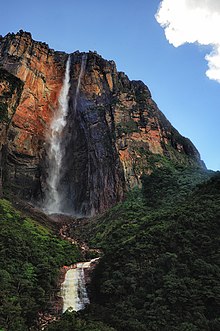Angel Falls
| Angel Falls | |
|---|---|
| Salto Ángel Kerepakupai Vená |
|

Angel Falls, Bolívar State, Venezuela
|
|
|
Location in Venezuela
|
|
| Location | Auyantepui, Canaima National Park, Bolívar State, Venezuela |
| Coordinates | 5°58′03″N 62°32′08″W / 5.96750°N 62.53556°WCoordinates: 5°58′03″N 62°32′08″W / 5.96750°N 62.53556°W |
| Type | Plunges |
| Total height | 979 m (3,212 ft) |
| Number of drops | 2 |
| Longest drop | 807 m (2,648 ft) |
| World height ranking | 1 |
Angel Falls (Spanish: Salto Ángel; Pemon language: Kerepakupai Meru meaning "waterfall of the deepest place", or Parakupá Vená, meaning "the fall from the highest point") is a waterfall in Venezuela. It is the world's highest uninterrupted waterfall, with a height of 979 meters (3,212 ft) and a plunge of 807 meters (2,648 ft). The waterfall drops over the edge of the Auyantepui mountain in the Canaima National Park (Spanish: Parque Nacional Canaima), a UNESCO World Heritage site in the Gran Sabana region of Bolívar State. The height figure 979 metres (3,212 ft) mostly consists of the main plunge but also includes about 400 metres (0.25 mi) of sloped cascade and rapids below the drop and a 30-metre (98 ft) high plunge downstream of the talus rapids.
The falls are along a fork of the Rio Kerepacupai Meru which flows into the Churun River, a tributary of the Carrao River, itself a tributary of the Orinoco River.
The waterfall has been known as the "Angel Falls" since the Mid-20th century; they are named after Jimmie Angel, a US aviator, who was the first person to fly over the falls. Angel's ashes were scattered over the falls on 2 July 1960.
The common Spanish name Salto Ángel derives from his surname. In 2009, President Hugo Chávez announced his intention to change the name to the purported original indigenous Pemon term ("Kerepakupai Vená", meaning "waterfall of the deepest place"), on the grounds that the nation's most famous landmark should bear an indigenous name. Explaining the name change, Chávez was reported to have said, "This is ours, long before Angel ever arrived there ... this is indigenous property." However, he later said that he would not decree the change of name, but only was defending the use of Kerepakupai Vená.
...
Wikipedia

